Russia's struggle with Swedish revanchism at the end of the XVIII century. Rosensalm and Vyborg
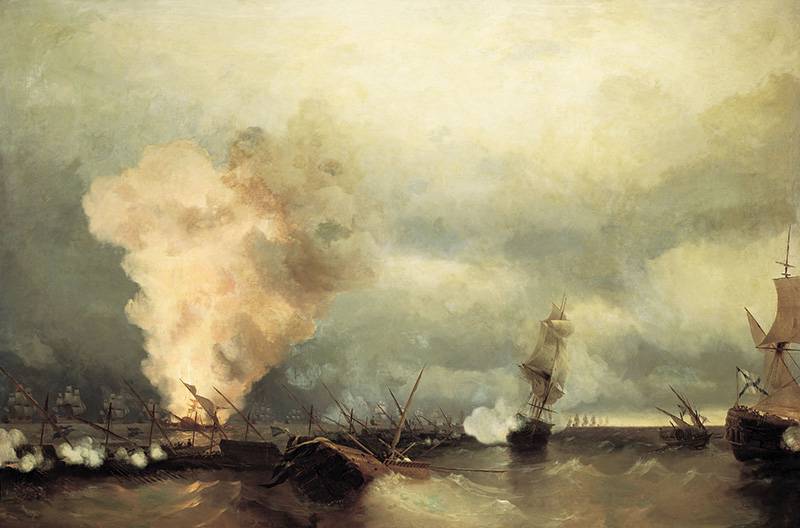
By the middle of 1789, the second year of the Russian-Swedish war, the situation at sea from an unspecified equilibrium began to gradually but firmly decline in favor of Russia. The Öland battle was more important than it seemed to those who saw in it only an indecisive exchange of fire at long distances. Yes, the sea was not littered with the wreckage of enemy ships, and from half-submerged boats they did not pray for the rescue of the sinking enemy. Important were the results and consequences. Admiral Chichagov, virtually without serious opposition from the Duke of Södermanland, managed to join Kozlyanin’s Copenhagen squadron with his ships and get a tangible advantage in forces. The Swedish commander, however, blamed his indecision in the Battle of Eland for openly failing actions of rearguard commander Rear-Admiral Lilliahorn, but after combining Chichagov and Kozlyanov he did not dare to give battle.
The Swedish fleet took refuge behind the batteries and forts of Karlskrona. Crews were deeply affected by the epidemic, and after returning from the campaign and the unsuccessful battle of Öland, the number of patients on battleships and frigates reached 7 thousand people. The watchful adversary was nearby, and now Chichagov was under the command of 33 battleships, 13 frigates and 7 transports. The Russian fleet cruised off the Swedish shores, provoking the duke Charles to go to sea and take the battle. However, the Swedes, despite the insistence of the king, who continued to wait for convincing victories, did not leave the anchorages. Only in August, when Chichagov went to Kronstadt to replenish supplies, did the Swedish frigates begin to make reconnaissance attacks on the Baltic. Throughout the 1789 campaign, the linear fleet of Gustav III did not dare to appear in the Gulf of Finland, but was content with the eastern Baltic.
But war at sea was not limited only to the actions of linear forces. Both sides had numerous and strong rowing fleets, and the clash between them was only a matter of time. Finland was the only land theater of war, its coastline abounded with numerous skerries. The opposing armies needed both the support of their coastal flanks and the solution of complex logistical problems. The Russian galley fleet did not meet the war at its best, especially with regard to the material part. All winter 1788–1789 in Kronstadt, intensive work was carried out to bring the galley fleet into a combat-ready state. Traditionally, there were not enough workers and materials, since the bulk of the available resources were absorbed by the linear fleet. The command of the galley fleet was entrusted to the energetic Prince Karl Nassau-Siegen. The need for the presence of rowing vessels in Finnish waters was urgent, since the ability to act in narrow skerries in large ships was limited. The Swedes freely delivered reinforcements to their troops and supplied them with everything necessary.
Preparations for the campaign dragged on, and as a result, only 8 June 1789, the Russian galley fleet left Kronstadt. It consisted of 75 ships of various classes: galleys, gunboats, dubel boats, and others. Nassau-Siegen headed for the Friedrichsgam Bay, where large forces of the Swedish skerry fleet, commanded by Admiral Ehrensverd, were already stationed. On the way, a detachment of brigadier P. B. Slizov joined the prince, coming from Vyborg as part of the 13 ships. 3 July 1789 Russian galley fleet was located at the entrance to the Bay of Friedrichshahm.
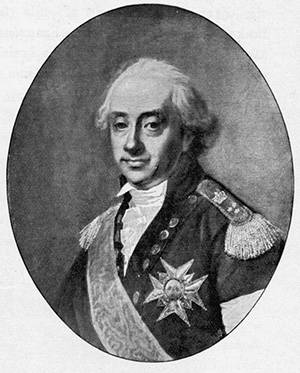
There was an 62 warship and 24 transport in submission to Ehrensverd (this number is indicated by fleet lieutenant N. V. Novikov in the book “History Russian fleet "). Alfred Stenzel in his work "The History of Wars at Sea" gives other numbers. According to him, the Swedes had only 48 ships with 270 guns and transports. Ehrensverd was anchored on the Rochensalmsk raid - a well-defended position, which could be penetrated only through two passes: from the south, between the islands of Mussalo and Kuutsalo, about 850 m wide, and from the north along an even narrower passage, called the Royal Gate. Coast straits Ehrensverd prudently strengthened coastal batteries. As an additional measure to strengthen the already not weak position, the channel of the Royal Gate was blocked by flooded transport vessels.
Nassau-Siegen did not rush headlong against the enemy, who had firmly entrenched in his navy hole, and began to wait for the approach of the so-called reserve squadron from Kronstadt under the command of Vice-Admiral A. I. Cruz (von Cruys). It consisted of two frigates, two bombing ships and several smaller ships. The preparation of the reserve squadron was delayed, and it joined the main forces only on August 4. Both Cruise and Prince Nassau-Siegen were active commanders, and each of them had his own view on the upcoming battle. Attempts to work out an agreed plan of action soon turned into recriminations and accusations, since both naval commanders were equal in their ranks, and each considered himself to be right. The empress resolved the dispute, displacing the obstinate Cruise and appointing Major-General I. P. Balle, who had previously held the post of fleet chief quartermaster, to replace him.
The preparations for the battle were completed by the night of August 13. As conceived by Nassau-Siegen, Balle, together with large 11 and 9 small rowing vessels, had to, after entering through the south aisle, pull the forces of the Swedes over, while the other part of the Russian fleet, under the direct command of the prince, would break through the Royal Gate and strike the enemy from the rear. The plan was risky, given the fact that the Russians were not aware of the fact that the Swedes flooded transport ships in the aisle of the Royal Gate. The fact is that Admiral Ehrensverd had long ago requested permission from the king to thoroughly block this vulnerable spot, but permission from Gustav III to donate several transport ships to create a barrier was received just a couple of days before the battle. Flooding was carried out in a hurry and without preparation, which ultimately affected the results of the battle.
First Battle of Rochensalm
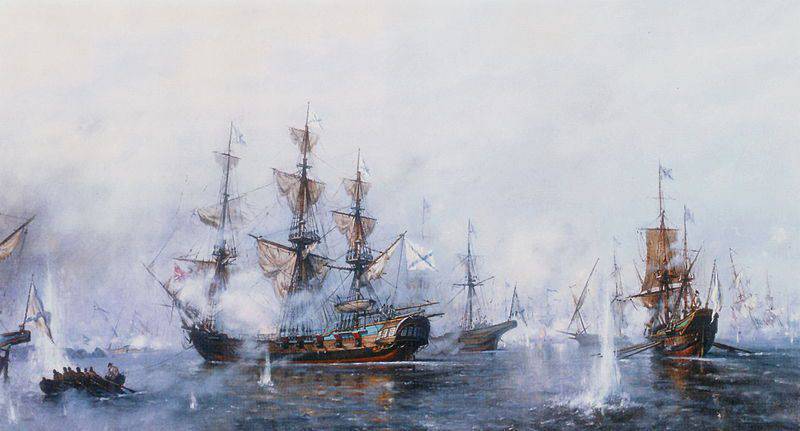
On the morning of August 13, Major General Balle’s ships broke off their anchors and moved towards the enemy. The Swedes opened heavy fire, believing that this was only the Russian avant-garde, and that Prince Nassau-Siegen was about to break through the southern side. Balle slowly, but stubbornly moved forward under the fire of not only the enemy ships, but also the coastal batteries that helped them. By noon, the Russian distraction squad managed to get close to the enemy at a distance of a shot-shot and build a battle line. The Major General understood well the mission entrusted to him: to divert as many Swedes as possible to his unit and completely capture their attention. The Swedes paid attention and intensely. Especially getting to the ships of the first line, on which, in addition to the multiplied damage, fires were soon added. The subordinates of Admiral Ehrensverd also suffered from the effects of Russian fire: two small gunboats were sunk, several more damaged disappeared behind the islands. Nevertheless, the fire superiority over the Balle detachment increased, as the enemy pulled all new ships to the line of battle.
While a relatively small detachment actually fought with most of the Swedish skerry fleet, Nassau-Siegen, having made a detour, started the attack through the narrow King's Gate. The forward detachment of the gallery was commanded by Count Litt, who soon stumbled upon the flooded ships. This news came as a complete surprise to Nassau-Siegen. All attempts to find some other passage were unsuccessful. There was a critical situation, when the Balle detachment was already exhausted from the superior forces of the enemy, and the main part of the fleet was trampling near the blocked fairway. There was only one way out: with the available means to clear the channel from obstacles. And this was done by volunteers who were not lacking. To the waist in the water, sailors, soldiers and even officers cleared the way for the fleet with crowbars and axes.
Ehrensverd soon learned of the imminent danger and sent several ships and floating batteries to the Royal Gate. He was still confident that the main Russian forces were attacking him from the south side, and a small sabotage detachment was trying to break through the narrow channel of the Royal Gate. In fact, it was just the opposite. The Swedes opened heavy fire, trying to prevent the clearing of the passage. Enemy nuclei caused great damage to the crowded hunters, but new ones were replaced with the dead. To support his improvised engineering team, Nassau-Siegen landed a soldier with several guns near the 400. The laying of the fairway lasted for almost four hours until Count Litta finally managed to break through to the rear of the enemy position. This happened just in time, because the detachment of Major-General Balle was in a desperate situation. His ships were in battle for almost five hours, most of them were badly damaged, there were serious casualties among the crews, and most of the ammunition was also spent. Seeing the disastrous state of the enemy, the Swedes began to shorten the distance and prepare for boarding. At the beginning of the seventh, Balle gave the order to get out of battle for the most affected ships, while the less damaged ones were to cover the departure. Encouraged by the difficulties of the enemy, the Swedish galleys came close, and in the ensuing fight they managed to capture the “Hasty” packet and the bombing ship “Perun”, which by this time had been badly damaged and had a large decline in people.
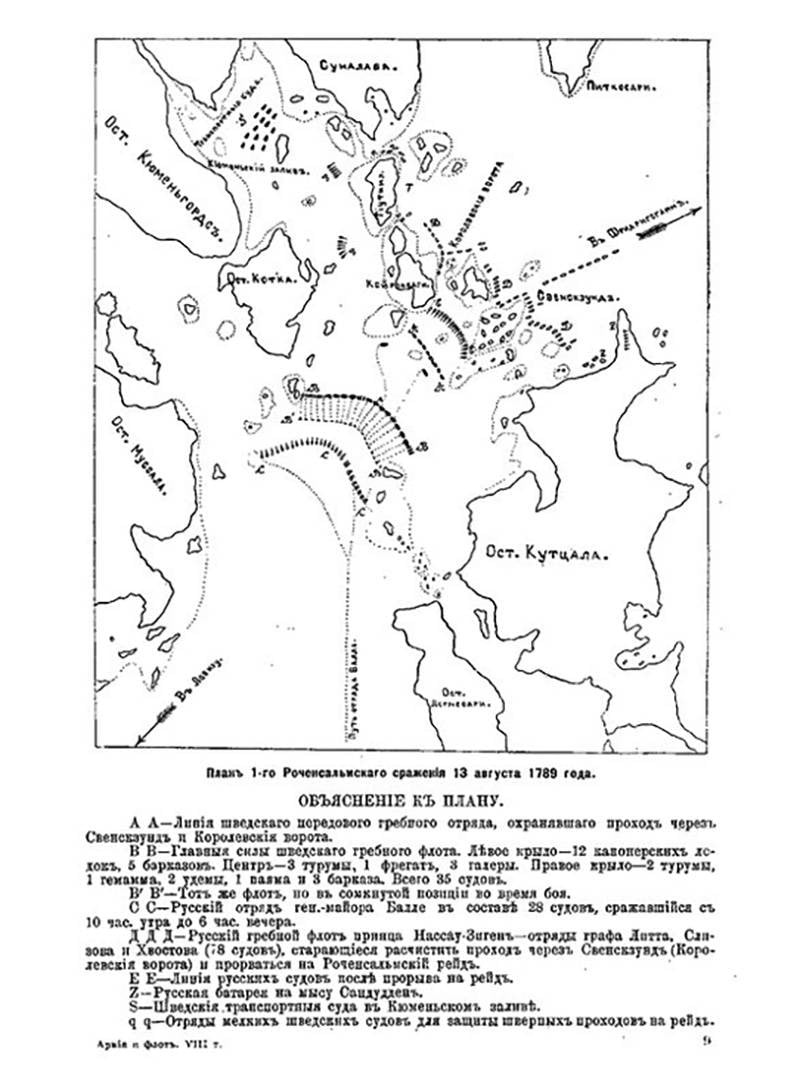
The triumphant Swedes had already calculated the possible size of the booty and were anticipating victory, when suddenly the situation on the battlefield had drastically changed. In the rear of Ehrensverd, the galleys of Count Litt appeared, one after another, leaving the cleared fairway. Since the Swedish ships themselves were by no means in a ceremonial state after hours of battle with the Balle squad, the prospect of meeting the fresh enemy was not very encouraging. A few galleys abandoned against the newly arrived enemy were soon put down by fire and put out of action. Count Litte and Prince Nassau-Siegen, who had joined him, immediately attacked the enemy. The line of Swedes mixed, now the Russians were moving closer to the enemy and were looking for boarding. Among the first were repelled "Hasty" and "Perun", whose tenure under the Swedish flag was very short. Then hand-to-hand fights began to boil on the decks of other enemy ships. The Swedish crews were tired of fighting, they were heavily loaded with ammunition. Soon, the St. Andrew's flag was raised above the Av-Troole rowing frigate armed with twenty-four 12-pounder guns and over two X-NUMX-cannon turum "Rogwald" and "Biorn-Erksid". In addition, another smaller turum, two galleys and three gunboats were taken.
In the Swedish fleet, large rowing vessels were named Turums, which received their name from the region in Finland Turunmaa. These were double-deck ships, which, as a rule, were equipped with 12-pounders on the lower deck and 3-pounders on the upper deck. The desire of the Swedes to increase the firepower of their navy fleet led to the emergence of large rowing ships with powerful artillery weapons. Such ships were built (turums, usdas, poyem) on the initiative of the chief builder of the royal fleet, Fredrik Henrik Chapman.
The preponderance in battle completely passed to the Russians, and Ehrensverd, not seeing for himself the prospects of its continuation, gave the order to retreat through the south-western passage to Loviz. The retreat was a big mess, many ships were badly damaged. Anchoring transports had to be burned along with all the supplies on them for the land army. The battle ended with the onset of darkness with the complete victory of the Russians. The number of captured officers was 37 and almost 1200 lower ranks. About a thousand more were killed and injured. Nassau-Siegen lost 58 officers and about 1000 lower ranks. Most of the losses were incurred by teams of Major General Balle’s detachments and volunteers who selflessly cleared the fairway of the Royal Gate. In addition, the 16-gun gallery “Tsivilsk” sank from the explosion, and the heavily damaged 19-gun gallery “Dnepr” was sent to Kronstadt to repair the damage, where its repair was considered impractical.
Suspended from command shortly before the Battle of Rochensalm, Vice Admiral Cruz later criticized Nassau-Siegen for his plan. The prince lost too much time for a detour, and his forces entered the battle too slowly. According to Cruise, the main forces had to attack from the south, and bypassing sent a small and, most importantly, high-speed squad to strike through the Royal Gate. Thus it was possible to completely destroy the entire Swedish fleet. However, the winners are not judged. The efforts of Vice Admiral Nassau-Siegen were appreciated by Catherine II.
After the victory, the prince suggested to the commander of the land army, General-in-Chief V. P. Musin-Pushkin, using the conquered coastal waters that he had gained, to land troops in the rear of the Swedish land army and, at the same time attacking it from the front, surround and force to surrender. However, the general general, already not distinguished by the rapidity of thinking, is steeped in strategic calculations. The lack of unity of command and interaction between the fleet and the army was a misfortune of the Russian command, not only in this war. While Musin-Pushkin made up his mind, the Swedish king, having learned about the plans of the Russians, ordered to shore up the land in dangerous places with powerful batteries, and the opportunity to end the war in the 1789 year was missed.
The second year of the war ended very unfavorably for the Swedes: among the army stationed in Finland, diseases raged (over the summer, losses in people amounted to more than 10 thousand people), the navy fleet was battered and upset. An admiral Chichagov, who was confused under the bow, constantly interfered with the final and irrevocable victory and become the master of the Baltic, and his three dozen battleships were an excellent sedative even for the distinguished riot of the king's king. The treasury was in desolation, and in military circles there grew deaf discontent with the absurd antics of the shocking Gustav III.
The third year of the war, the failure of Gustav III's offensive plans. Vyborg battle
The plan of the new campaign largely proceeded from the circumstances in which Sweden ended up by the third year of the war. The economy, exhausted by the burden of military spending, was subsidized by foreign fans of King Gustav and his noble cause. Allied Denmark, Russia under foreign political pressure, finally, ended its very strange war and concluded peace with the Swedes, returning to the status quo. Russia actually waged a war on two fronts, among other things, the traditional domestic political chaos in Poland began to take sharp forms. These circumstances inspired the king to quickly end the war - certainly on a victorious note. The monarch's military optimism was not divided, but they were forced to obey. The line fleet was instructed to prevent the unification of the Russian squadrons hibernating in Kronstadt and Revel and smash them one by one. After that, it was planned to unite with the galley fleet, defeat the Russian rowing forces, take Vyborg and secure from the seaside flank the offensive of the land army towards St. Petersburg. The Swedish fleet was brought to 25 battleships, 15 large frigates and several dozen ships of other classes. The navy fleet, put in order after the Battle of the Rochensalmsk, numbered about 350 units. By the beginning of the campaign, the Russian fleet had combat-ready 30 battleships, 13 frigates and more than 200 rowing ships. Having shown himself to be a low-initiative commander, General-in-chief Musin-Pushkin was replaced by a more active one, in the opinion of the empress, I. P. Saltykov.
Vyborg trap
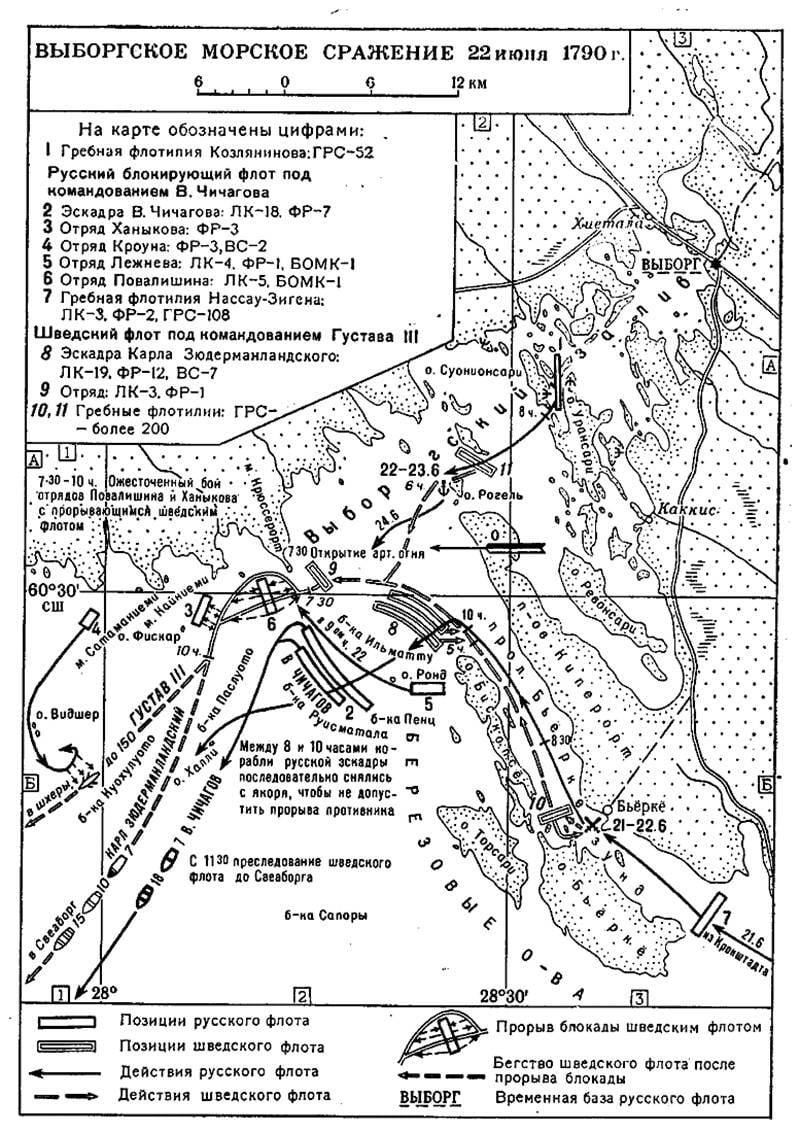
From the outset, the generally logical and not hopeless Swedish military plan began to falter. Although the offensive undertaken in the spring in Finland brought limited success to Gustav: the Russian troops retreated in some sectors, a completely different picture emerged at sea. Attempts to defeat the Baltic Fleet formations one by one led to the Revel and Krasnogorsk naval battles, in which the Swedish fleet suffered an obvious failure. The Russians were not only defeated, but nothing prevented them from joining forces. After the battle of Krasnogorsk 26 in May, the Swedish fleet retreated to Vyborg Bay, where anchored between Cape Cruiserourt and the northern tip of Paysari Island. A total of 22 battleships, 10 frigates and around 200 skerry ships, which had a 14-thousandth landing force for a close, but, as it turned out, unattainable Petersburg, were located in this area.
Many ships were damaged in previous battles, there was a lack of ammunition. The morale of the crews following successive failures was undermined. But the biggest disaster for the fleet that had crowded in the Vyborg gulf was not even the Russians, but the presence of the king on board. Unfortunately for his subjects, the Swedish king in all seriousness considered himself to be a militarily gifted person and, relying on this confidence, constantly gave advice and orders to his flagships and commanders. All attempts of the Duke Karl Södermanland as a fleet commander and his brother to persuade Gustav not to joke with fortune, but to retreat to bases where the ships could be put in order and restocked, were blithely rejected. The fleet was anchored at the enemy shore, and His Majesty consoled himself with the thought that with his triumphant standing he threatened the enemy capital and intimidated Catherine II. The royal court really several times during the war became very nervous from the proximity of the enemy and then ordered the carriage to be laid, then he took a breath of relief. However, this did not affect the overall situation.
8 June in Vyborg appeared Russian fleet under the command of Chichagov, holding the flag on the "Rostislav". He had 27 battleships, 5 frigates, 8 rowing frigates and a dozen other ships. The Russian rowing fleet was divided - part of it (52 units) under the command of Kozlyaninov was directly in Vyborg, actually cut off from the main forces. The main forces (89 ships) under the command of the active Nassau-Siegen 13 June left Kronstadt, advancing to the scene.
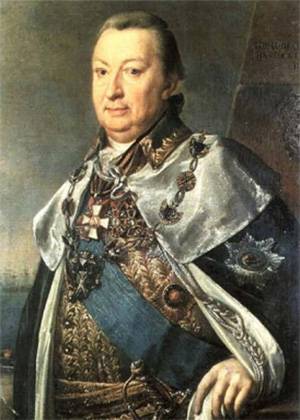
Almost all of June, the opponents stood waiting. Cautious Chichagov preferred to watch the enemy, blocking by patrol detachments all possible passages between the islands. The initial distance between fleets in 8 miles to June 20 was reduced to 4. By this time, Nassau-Siegen had arrived with its galleys to the scene, and the blockade of the Swedish fleet was tight. Chichagov, not without pressure from the younger flagship Cruise and the energetic Nassau-Siegen, began to lean toward a general attack by the forces of his own ship fleet, the rowing fleet, which arrived from Kronstadt, and the Vyborg squadron. Especially since the position of the Swedes became increasingly difficult.
Freshwater supplies were coming to an end - access to coastal sources was blocked by Cossacks and arrows. The food situation was so bad that the crews were given only a third of the ration. The Swedish command continuously deliberated, and His Majesty plunged into the quiet confusion of the admirals and flagships with their options for further developments. Particularly vividly stood out among them was the proposal to disembark all the landing forces along with most of the crews, to burn some of the ships and attack St. Petersburg, and in case of failure to save, as possible, it is possible that by swimming. All exhortations on the breakthrough to the west by the king were resolutely rejected as signs of cowardice.
Finally, the Duke Charles managed to persuade his brother to listen to the subtle voice of reason and to give permission for a breakthrough in order to take advantage of the blown favorable oriental wind. The operation to extract the fleet from the bag, in which he found himself by the grace of Gustav, was being prepared in detail. A plan was adopted and approved by a certain Lieutenant Clint, who knew the local fairways. According to him, the Swedes had to leave the bay in the same way that they went there, and where the Russians were waiting for the movement in the last place. The ships had to go in the same order as they were anchored, without any rebuilding, while the army fleet was to move along the right traverse of the linear forces, which, if necessary, would have protected it from attacks. It was planned that boats and small rowing vessels with special crews to assist would immediately follow the ships stranded. Marseilles and staysails on the masts were left loose at night, so that they could be delivered without sending new people upstairs. As soon as the flagship gave up the Marseilles, all the other ships, without waiting for the signal, should have done the same.
Swedish breakthrough
At 6 in the morning of 22 on June 1790, the Swedish fleet was set in motion. He withdrew from the anchors and began to move through the northern fairway past Cape Cruiserort. Parallel to the main forces, but closer to the shore, there was a rowing fleet and transports. Chichagov, seeing the actions of the enemy, ordered his battleships to stand on the spring and get ready for battle, apparently assuming that the enemy was attacking the main forces of the Russian fleet. However, the Swedish plan did not provide such evidence. In 7 hour. 30 min. The leading Swedish battleship 74-gun "Drizigheten" approached close to anchored Russian frigates from the blocking detachments Povalishin and Khanykov, showered them with powerful longitudinal volleys. Russian ships fiercely resisted, but were soon badly damaged. The Swedish fleet, division by division, passed by them, but Chichagov did not move, expecting the Swedes to change their intentions and rush to attack him.
Only in 9 hours of the morning the admiral gave the order to be removed from the anchor. By the beginning of the tenth morning, the head of the Swedish column was already in clear water. While traveling in clubs of powder smoke that enveloped the northern part of the Vyborg Bay, the Swedish battleships Edwig-Elizabeth-Charlotte, Emheiten and Louise-Ulrica, two large frigates and several small ships were stranded and were lost. The terminal battleship in the convoy, the Enigheten, clashed in close quarters with the Swedish brander intended for the frigates of Povalishin. The flames were raging on the fire, and soon both ships exploded.
Unfortunately, the slowness of Chichagov did not allow to take advantage of the confusion of the enemy. By 11 hours the entire Swedish fleet has already gone to sea. The Russian fleet moved behind him in the wake, but far behind. In parallel to him, closer to the shore, the Swedish skerry flotilla moved, but Chichagov did not pay much attention to it, considering the enemy’s linear forces to be the main target. The galleys of Nassau-Siegen and Kozlyaninov were far behind the stern of the end ships of Chichagov, trying to reduce the distance by forced rowing. Toward evening, in the Gogland region, the Swedish frigate Sophia-Magdalena, lagging behind its own, was captured and damaged in the battle of Krasnogorsk and therefore had speed problems. Chichagov singled out several of his ships to intercept the enemy’s rowing fleet, but this was glaringly small. Nassau-Siegen and Kozlyanin were too far away and could not take part in the destruction of enemy rowing forces. Russian frigates crashed into the thick of tight-running Swedish galleys, the morale on which was so low that many of them stopped the course and lowered flags. However, the frigates that were close to such a mass of potential prey were too few. And a number of Swedes, seeing that the enemies did not have time to accept the surrender of everyone, again raised the flag and began to move. Nevertheless, the pursuers managed to capture the rowboat 21 and 6 transports. At one of the galleys, the Swedish king’s breakfast, consisting of roasted goose and a bottle of vodka, was even captured. However, the fattest "goose" in the face of Gustav III managed to escape on a high-speed rowing boat.
The captain of the 2 rank Crone acted with initiative, commanding a magnificent walker - the captured frigate Venus. The next day, he attacked the 64-gun ship of the Retvizan, which had lagged behind the enemy column, aboard, and was subsequently awarded the Order of St. Vladimir 3 degree, the rank of captain of the 1 rank and a lifetime pension. The Swedish ship fleet took refuge in Sveaborg, and having escaped with a strong fright, and yet the surviving navy-based fleet hid in Finnish skerries.
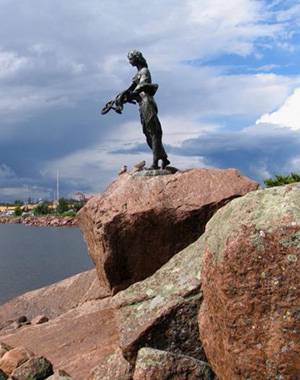
On the one hand, the battle of Vyborg, of course, is a Russian victory. The Swedes lost their 3 battleships, another 4 were taken by the Russians as trophies in varying degrees of integrity. 1 frigate burned, 2 surrendered. Losses in rowing vessels - sunken and captured - were in the area of 50 units. Only captured Swedes lost about 4600 people. The Russians had 147 dead and 164 wounded. The Swedish ship fleet lost almost a third of its composition, a part of the ships was badly damaged, the dominance of the Baltic passed to the Russians. On the other hand, Chichagov’s excessive caution prevented the destruction of virtually all the present Swedish forces led by the king and ended the war with one blow. The actions of the Russian commander were criticized in a military environment, but Empress Catherine II had her own vision and awarded Chichagov with the Order of St. George 1 degree.
Militarily, Sweden found itself in an extremely difficult situation - there could not have even been a question not only of landing operations under the walls of St. Petersburg, but the question arose of the very possibility of continuing military operations. Even the defeat of Nassau-Siegen, who was thirsting for military glory in the second rochesalmsky battle of 28 in June of 1790, did not change the overall picture. Fascinated by nature, Gustav III lost interest in intimidating the Russian empress and other Finnish military ventures. Now he was completely consumed by the idea of helping Louis XVI, who was in distress in the country seized by the revolution. These ideas were discussed, not without awe, by the king’s entourage, especially since a possible military expedition to France with the aim of restoring the “brother Louis” on the throne had the same chances of success as the search for snowdrops on New Year's Eve. And yet the indefatigable Gustav managed to beg for money for a “good deed” even from Catherine II, who only needed European gentlemen to be completely absorbed in French affairs and not prevent Russia from taking control of the Black Sea straits under the guise. Gustav’s strategic search projects had already angered both the aristocracy and the military elite, and the lover of operas, the composer of dramas and plays, the unlucky commander was mortally wounded in the Stockholm opera 16 in March 1792, where he defiled in a fancy dress. A few days later the king passed away. After his death, his son Gustav IV Adolf, also the unlucky king, overthrown by a military coup, ascended the throne. Russia was waiting for a victorious end to the war with Turkey and a quick conflict with revolutionary France.
Information